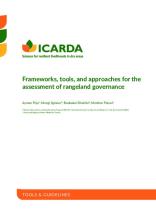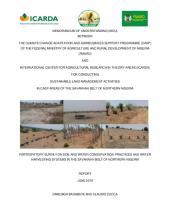Land Library
Bem-vindo à Biblioteca do Land Portal. Explore nossa vasta coleção de recursos de acesso aberto (mais de 74.000), incluindo relatórios, artigos de revistas científicas, trabalhos de pesquisa, publicações revisadas por pares, documentos jurídicos, vídeos e muito mais.
/ library resources
Showing items 37 through 45 of 380.Presentation on "Climate-resilient food legumes for higher and sustainable productivity of rain-fed crop lands in Central Asia" submitted during the Central Asia Climate Change Conference, 3-4 April 2019. Tashkent, Uzbekistan.
This document aims to contribute to the empirical development of effective approaches for the assessment of rangeland governance at local levels, and provide insights about major governance drivers through the quantitative assessment of their effects.
The living lab approach underlying LANDSUPPORT activities is aimed at involving policy and decision makers and potential users from the very beginning and throughout all project phases, ensuring that the delivered DSS tools can actually be used.
This report aims to illustrate how selected companies in Malawi, Mozambique and Malaysia are implementing commitments to international best practices on land rights.
The Climate Change Adaptation and Agribusiness Support Programme (CASP) of the Federal Ministry of Agriculture and Rural Development of Nigeria (FMARD) aims at mainstreaming climate change adaptation measures in the savannah belt of Northern Nigeria, through a landscape rehabilitation approach fo
Double up legumes is intercropping two legumes (in this case groundnut and pigeonpea) that have different growth habits and takes advantages of beneficial interactions of the two legumes on the same piece of land.
This report is the results of the mid-term review for the EU-IFAD project "Restoration of degraded land for food security and poverty reduction in East Africa and the Sahel: taking successes in land restoration to scale" Project.
In response to the severe economic, social, and environmental costs of degradation across Tunisia’s rangelands, the International Center for Agricultural Research in the Dry Areas (ICARDA) has worked with the General Directorate of Forestry (Direction Générale des Forêts, DGF) to draw up a new pa







